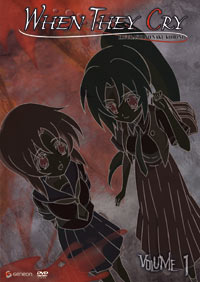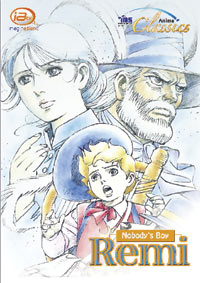Shelf Life
When I Cry
by Bamboo Dong,

| Shelf Worthy |
| Ghost in the Shell: Solid State Society DVD |
| When They Cry DVD 1 |
| Rental |
| Nobody's Boy Remi DVD 1 |
| The Third DVD 1 |
| Perishable |
| Naruto: Protect the Waterfall Village! DVD |
When I first started writing this particular column, I was fuming aboard a plane to Atlanta, en route to Baltimore for Otakon. Every minute that went by was another minute spent in scathing anger at TSA. This all started at John Wayne Airport, where Zac and I were scheduled to fly to our connection in Cincinnati. As I approached the gate, the woman informed me that security had forgotten to pull me out for SSSS screening, and that I would have to go back and speak with TSA. “You'd better hurry!” she exclaimed, dripping with insincerity. I jogged back to the security line, where, after being bounced around to a few uniformed, uninterested workers, they finally herded me into the Terrorist Pit, where they probed my laptop with fabric swatches and frisked me for any weapons that may have miraculously eluded the metal detector. To cut a long story short, I missed my flight, thanks to the aforementioned woman closing the gate door in my face. If there was a list of National Agencies Who Don't Understand the Concept of Urgency, TSA would be somewhere in the top five, sandwiched between the DMV and the United States Postal Service.
Welcome to Shelf Life.
 To soothe my mind from all the anger I experienced that morning, the only thing I wanted was something violent, possibly sinister, and definitely something that had cyborgs. Luckily, I had a copy of Ghost in the Shell Stand Alone Complex: Solid State Society. It comes in an attractive tin and includes three discs—the movie, a disc of extras, and the CD soundtrack. The film itself gives you the option to view the storyboards in an inset. How fitting, though, that the opening scene takes place in an airport. I bet Batou doesn't get crap from TSA. To soothe my mind from all the anger I experienced that morning, the only thing I wanted was something violent, possibly sinister, and definitely something that had cyborgs. Luckily, I had a copy of Ghost in the Shell Stand Alone Complex: Solid State Society. It comes in an attractive tin and includes three discs—the movie, a disc of extras, and the CD soundtrack. The film itself gives you the option to view the storyboards in an inset. How fitting, though, that the opening scene takes place in an airport. I bet Batou doesn't get crap from TSA.Taking place two years after the end of 2nd Gig, the film shows a Section 9 much different than how it was before—for starters, the Major has left, and Togusa has taken up the position of squad commander. Playing out much like an extended episode, Solid State Society follows a dangerous case involving strings of suicides, thousands of missing children, the rotting elderly, and a deadly virus. With so many seemingly unrelated incidents, it's not until the end that everything starts fitting together like an elegant jigsaw puzzle of government conspiracy and technological terror. The only thing that the characters know is that their leads keep dying one by one, and in the middle of it all is a mastermind known only as Puppeteer. For those that remember Ghost in the Shell: Innocence, Solid State Society is completely different in most regards. Gone is the pretension, gone are the awkward Milton quotes—this film really is just a feature-length episode. This does come with some downfalls, though; given the longer running time, the writers were able to weave an incredibly complex story, but this also makes the pacing a bit stiff. So much is going on that everything is crammed together at the last possible second, and although it's fun seeing everything revealed all at once, some parts are a bit of a leap. Fans of Ghost in the Shell: Stand Alone Complex will definitely enjoy this movie. It doesn't exactly make for a mind-blowing finale after watching the entire TV series, but it fits in well with the rest of the franchise. Much of the stylistic elements are retained, and although the ending feels a bit cluttered, the journey there is too much fun to pass up. Plus, it's another chance to listen to more of Yoko Kanno's music, which makes a reprisal in the film—another reason why including the soundtrack with the movie was a great idea. There's absolutely no reason for any Ghost in the Shell fans to not check this out.[TOP] |
 As I rooted for another DVD to pop into my player, my eyes alighted on the first volume of The Third, the subtitle for which is “The girl with the blue eye.” Released by the folks at Right Stuf, this is one of the most innocuous series I've ever seen. It tells a fairly interesting story, without really allying itself to any one genre long enough to put anyone off. As an unfortunate consequence, it comes off as a bit flavorless. Mixing mecha, as well as supernatural elements, and a bit of recycled comedy (“how dare you call me flat-chested!”), The Third flails around a bit during the first few episodes, but the premise it eventually sets up looks to have potential. As I rooted for another DVD to pop into my player, my eyes alighted on the first volume of The Third, the subtitle for which is “The girl with the blue eye.” Released by the folks at Right Stuf, this is one of the most innocuous series I've ever seen. It tells a fairly interesting story, without really allying itself to any one genre long enough to put anyone off. As an unfortunate consequence, it comes off as a bit flavorless. Mixing mecha, as well as supernatural elements, and a bit of recycled comedy (“how dare you call me flat-chested!”), The Third flails around a bit during the first few episodes, but the premise it eventually sets up looks to have potential.The star of the show is Honoka, a sweet, introspective girl who calls herself a jack-of-all-trades. With amazing sword skills and crazy reflexes to match, she and her AI buddy take on odd jobs, like transporting cargo, or exterminating enormous arthropods. Her routine is shaken up when she meets an eerie pretty boy in the desert, who seems to know something that the government wants. Using her newly purchased mechanized combat suit, Honoka finds herself fighting to protect herself, her friends, and the townspeople that have become her family. While the series does take a while to settle into a comfortable pace, the overall atmosphere is one that is very easy to watch. It's very relaxed and dreamy, and even the fights are almost elegant. But… all of that is broken up by the narrator. The narrator is actually the worst part of the show. Somewhere in the creative process, the creators decided that they couldn't accomplish whatever it is they wanted to just using visuals and dialogue, so they dragged in some old man to explain the characters' emotions. You see, the catch is that the main character is so stoic, that her inner feelings can only be described by an omniscient voice, who does so in the most patronizing, silliest way possible. With lines like, “'I've come to the desert again…' words Honoka murmurs to herself over and over, as if to reaffirm the odd sense of calm she feels there,” it's hard to not roll your eyes. It doesn't help that his lines are intoned much like the “Wii stance” voice in the latest Wariorware: Smooth Moves. If someone told me both the Japanese and English narrators did dramatic readings of Oprah Book Club selections at Borders every Tuesday night, I'd believe them. It's hard to really dislike this show, because it's so earnest, but at the same time, it takes a certain kind of person to really enjoy it. Diehard action-centric mech fans will likely be turned off by its easy pace, recitation of bad poetry, and the amicable, but pointless, chit-chats between the characters, but for the casual viewer, this is an entertaining enough show. Personally, I'd prefer the series to have more of a solid direction and spend less time engaged in meaningless dialogue, but hopefully it's something that will improve as the show continues.[TOP] |
At this point, I really feel like I should mention that I've been listening to “Heavenly Star” by Genki Rockets on repeat for maybe two days straight. I don't know what it is about this song, but the chorus makes me intensely happy, and if I hadn't gone to school for so many years, I'd be tempted to leap off a cliff, just to see if the lyrics would grant me the ability to fly. Luckily, education is mandatory in the United States. In a vain attempt to flush the uplifting song from my head, I scoured my review pile for something needlessly violent. Surely, something called “When They Cry” has got to be filled with blood and pain.
 Having never heard of When They Cry before, I didn't know what I was getting myself into. Within the first 8 seconds, though, I knew it was going to be a bloody good time. When They Cry is structured like a series of crescendos, with each arc starting as little more than cutesy dialogue and giggly girls. Over the span of four episodes, it culminates into a frightening bloodbath of nerves and paranoia. It's been a while since I've seen a horror series with such a carefully constructed atmosphere of fear. Then, once it ends, it resets itself, and tells a parallel story of death and destruction. Having never heard of When They Cry before, I didn't know what I was getting myself into. Within the first 8 seconds, though, I knew it was going to be a bloody good time. When They Cry is structured like a series of crescendos, with each arc starting as little more than cutesy dialogue and giggly girls. Over the span of four episodes, it culminates into a frightening bloodbath of nerves and paranoia. It's been a while since I've seen a horror series with such a carefully constructed atmosphere of fear. Then, once it ends, it resets itself, and tells a parallel story of death and destruction.This show is really amazing. What makes it work so well is that every arc is preceded by a scene that shows you exactly how the final death will play out. It balances out the slow build-up of tension perfectly, and frankly, who doesn't want to stick around to see why a girl would bash her head into a butcher knife? The series has a core cast of five characters—Keiichi, a new transfer student to a small village school, and four other girls, who have been living there for a while. And, like all small villages, there's something vaguely unsettling about it—in the case of Hinamizawa, deaths occur every year during the Cotton Drifting Festival. Rumor has it, it's all the work of the demon that watches over the townsfolk, but then again, demons don't generally take the shape of little schoolgirls… When They Cry is very unique, both in the way that the characters “reset” after every arc, and in the way that it blends in the supernatural so seamlessly with hints of paranoia and psychosis. Once you start watching, it's hard to rip yourself away, and the actors do such an amazing job of transitioning between Cute and Crazy that everything is completely believable. Plus, aren't you curious why girls are getting clubbed to death by a baseball bat?[TOP] |
Now, for something a little different. Those with a penchant for old, obscure anime will likely be hailing ImaginAsian in the months to come. They've taken it upon themselves to release a handful of old series, and, with 6 episodes on a disc at only $12.99 each, it's quite a steal.
 One of their first ventures is Nobody's Boy Remi, a depressing story about a boy who's sold by his adoptive father to a traveling entertainer. Or rather, that's just the set-up for the series. The real adventure really comes in watching Remi grow up, adapt to a wholly different life, and set out on his own. The pacing is pretty slow, but if you have the patience to sit through it, it's a rewarding experience. The animation, dating from the late-70s, is beautiful, with surreal watercolor backgrounds and oversized pans that set the series apart from much of the bright, gaudy visuals seen in many new series. One of their first ventures is Nobody's Boy Remi, a depressing story about a boy who's sold by his adoptive father to a traveling entertainer. Or rather, that's just the set-up for the series. The real adventure really comes in watching Remi grow up, adapt to a wholly different life, and set out on his own. The pacing is pretty slow, but if you have the patience to sit through it, it's a rewarding experience. The animation, dating from the late-70s, is beautiful, with surreal watercolor backgrounds and oversized pans that set the series apart from much of the bright, gaudy visuals seen in many new series.While the series eventually unfolds into a coming-of-age tale of a boy whose life is suddenly thrown into chaos, the first few episodes are a bit choppy. It takes a bit of time to get Remi on the road, and while this part of his back story is essential, it seems a bit awkward because once he leaves, there's no follow-up done on his previous family. The logic behind this makes sense, as the series is focused on Remi, but it makes it harder for viewers to care what's happening to him, as he's peppy enough just getting a new pair of shoes from his new guardian. Nobody's Boy Remi is like nothing else you'll find on store shelves. It's a quiet series more akin to reading a novel while listening to classical music than anything else. It's a beautiful piece of work, and for fans who like their shows to be a little more relaxed, then this one will definitely charm you. Somebody needs to put this thing on PBS.[TOP] |
Certainly, something like Remi is a bit more of a lost treasure than something that actually claims to be “lost,” like a Naruto OVA.
 Mission: Protect the Waterfall Village! is one of those Naruto OVAs that makes you wonder why they even bothered releasing it as an OVA. Surely, there's nobody out there aching for so much Naruto that they'll run to the store at 8AM to grab one of many standalone fillers to come. Clocking in at 40 minutes, the “lost story” is little more than a slightly longer episode that just won't fit in anywhere else. Mission: Protect the Waterfall Village! is one of those Naruto OVAs that makes you wonder why they even bothered releasing it as an OVA. Surely, there's nobody out there aching for so much Naruto that they'll run to the store at 8AM to grab one of many standalone fillers to come. Clocking in at 40 minutes, the “lost story” is little more than a slightly longer episode that just won't fit in anywhere else.Naruto and his crew are hired to escort some pansy leader from the Village Hidden in the Waterfall. His secret is that he has access to something called Hero's Water, which will allegedly boost your chakra and give you crazy ninja powers. Truthfully, it's probably just double-distilled water, but hey, whatever keeps you leader. As one would guess, a bunch of rogues jump Naruto and company, and in a flurry of jutsus and fireballs, and some motivational speaking, they SPOILER ALERT defeat the bad guys and win their Respect. If you've been watching Naruto all this time, and you've been buying all the DVDs, I can't really imagine why you'd desperately need this in your collection. There's nothing terrible about it, but it's so mediocre and generic that I don't see why someone would really miss out by not owning it. My best advice is to just mute the next episode of Naruto you see, and dub over it yourself, adding in phrases like “I'll protect Waterfall Village, believe it!” and “I don't need Hero's Water—I'm a REAL hero!” Maybe to enhance the experience, you can drink a bottle of Vitamin Water at the same time.[TOP] |
Well, that's that. See you next week! BELIEVE IT!

This week's shelf comes to us from Alex Anderson. There wasn't a story attached with the email, but those shelves speak for themselves. And look, a Last Exile goat!!


Baaaaaaah.
Want to show off your shelves? Send your jpg(s) to shelflife at animenewsnetwork dot com!
discuss this in the forum (39 posts) |